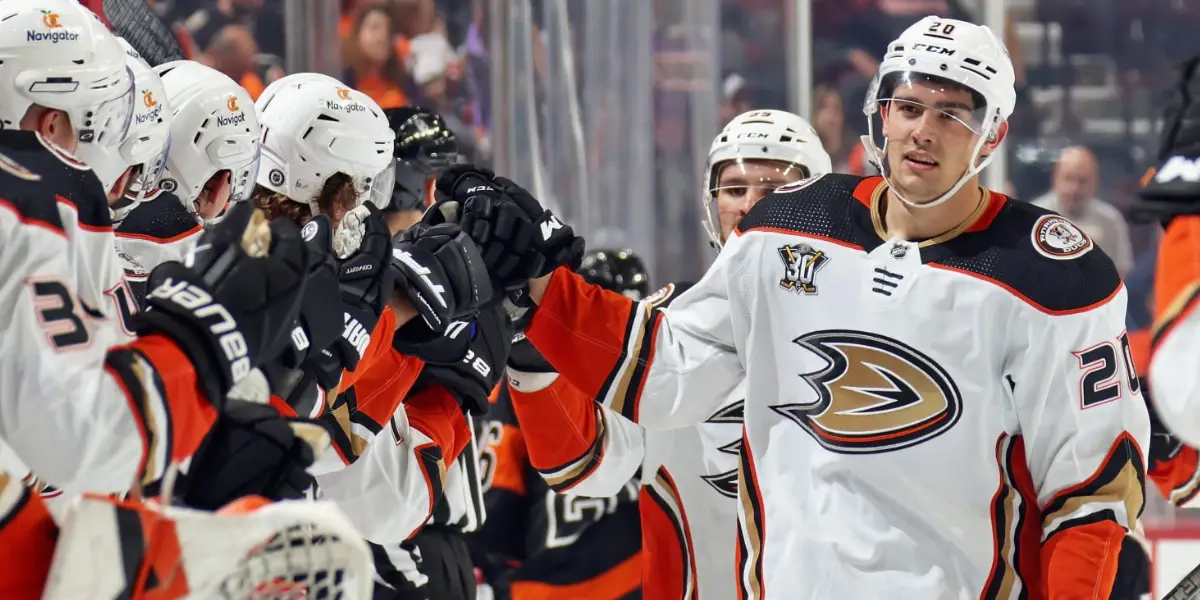
“I want [the Anaheim Ducks] to start taking a step and building toward being in a playoff race next season.”
The Ducks’ general manager, Pat Verbeek, has a busy summer ahead of him to make good on this promise from the March 2024 Duck Migration event. Following a disappointing season riddled with injuries, penalties, and a marginally better record than 2022-2023, Ducks fans are eager to see movement in this off-season that may lead to a team ready to, at the very least, not finish in the bottom 5 of the league.
Verbeek has made other comments about the future of the team’s roster, claiming that his priorities are signing a top-six right shot forward and a top-four right shot defenseman, as well as looking for more production in his bottom-six. While most of these acquisitions will likely come through unrestricted free agents, the Ducks still boast a slew of restricted free agents on their roster available to sign before mid-July. Let’s explore a case for each of the Ducks’ seven restricted free agents who spent significant time with the big club.
Drafted by the Ducks in the second round of the 2018 draft, forward Benoit-Olivier Groulx didn’t make his NHL debut until the 2021-2022 season, where he produced 3 points in 18 games played, and has since been only an occasional fixture of the Ducks 23-man roster.
With just 2 points in 45 games played and just 32 shots on goal, Groulx wasn’t quite a star producer for the team. Defensively, he put up a solid showing on a team that struggled to shut down opponents throughout most of the season. He was in the top 10 for hits (101) and top 15 for blocked shots (30) amongst his teammates. The centerman was handy in the faceoff circle as well, winning 44% of the 275 faceoffs he faced, putting him behind only Mason McTavish and Ryan Strome when compared to teammates still on the roster.
The bottom line: Groulx’s statistics leave much to be desired for a team that’s looking for high levels of production out of their bottom-six. From an eye test, his play was frequently forgettable at best. If Verbeek is looking to clean house before next season, Groulx could certainly be one of the first on the chopping block.
When left winger Max Jones was drafted in the first round of the 2016 draft, fans had high hopes about his ceiling. A high producer in junior leagues prior to his signing, he found his spot on the roster for the first time in the 2018-2019 season.
This season, Jones played 52 games and tallied 15 points (5 goals, 10 assists). While he showed flashes of the high-octane physical play he is capable of, injuries bogged down most of his momentum and the chemistry he attempted to build with his linemates. Still, he ended the season near the top of the pack in hits (127) and has the off-ice advantage of being well-liked in the locker room.
The bottom line: When looking at Jones’ play, there are some indicators that he still could produce for this team. But, at 26-years-old, he should technically be in his prime. His size and speed could slot him well into the future fourth line, though 15 points might not be the level of production Verbeek wants to see out of those players. Overall, Jones seems to be a 50/50 that might warrant a small short-term deal, if the price is right.
Another Ducks second-round draft pick, defenseman Jackson LaCombe, had a productive college career at the University of Michigan before making his NHL debut. He played two games with the Ducks at the conclusion of his 2022-2023 NCAA season but found a more consistent spot on the big league roster in 2023-2024.
LaCombe’s first full NHL season proved to be a bit up and down. As a high-level defenseman and power play quarterback in his college career, there were high hopes for the Minnesota native. In 71 games played, he tallied 17 points (2 goals, 15 assists) and was second in blocked shots (129) on the team behind his frequent defensive partner Radko Gudas. While he struggled at times on both sides of the ice, the end of the season gave fans a preview of his dynamic puck movement and offensive potential, especially when paired with a strong shut-down defenseman like Gudas.
The bottom line: LaCombe’s rookie season may not have been a standout, it was just that: a rookie season. LaCombe seems to still be in the plans for the young core on this team, especially after the addition of Olen Zellweger to the lineup, which allowed him to move away from playing on his weak side and onto a line with Gudas. Based on Verbeek’s dealings in the 2023 off-season, it wouldn’t be surprising to see LaCombe get a small bridge deal- he’ll be an RFA until 2028- to see how the next few seasons shake out. Still, LaCombe seems like a safe bet to see signed again before the deadline in July.
One of two waiver claims on this list, forward Brett Leason was drafted by the Washington Capitals in 2019 and immediately reported to their AHL affiliate, the Hershey Bears. After a stint with the Capitals, during which he played 36 regular season games and one playoff game, he was placed on waivers in October 2022 and subsequently claimed by the Ducks.
Leason’s first season in Anaheim, frankly, didn’t show much promise. Over 54 games, he produced just 9 points (6 goals, three assists) and was a -21. This season, he seemed to put a lot of effort into improving his game, doubling his production with 22 points in 68 games and working hard defensively as well. He was a primary part of the penalty kill when he was in the lineup- a high-stakes job when you’re on the most penalized team in the league- and spent just over 148 of his 885 minutes on the ice shorthanded. This resulted in two shorthanded goals, the second most on the team.
The bottom line: After a season of proving himself to be defensively sound and offensively improving, Leason seems like the kind of depth guy Verbeek might want to keep around, especially if he’s not looking for much of a raise on his $775,000 AAV contract. However, Greg Cronin did make some comments on his play throughout the season, pointing out gaps in his play, and occasionally opted to scratch Leason in favor of the more physically threatening Ross Johnston. With hopes for a productive fourth line, though, and a young core putting in hours in the weight room, maybe the physical presence will become less important in the future. Like Jones, this one seems like a 50/50 chance, but Leason may take the slight edge.
The second waiver claim, defenseman Gustav Lindström started his NHL career in 2019 with the Detroit Red Wings. Traded to the Montreal Canadiens in 2023, he played 14 games with that club before being placed on waivers and claimed by the Ducks.
In Anaheim, Lindström played 32 games and tallied 0 goals and 6 assists. While not particularly quick or offensively-minded, Lindström ultimately brings responsibility to the table. Finishing a +12 overall, he was frequently able to interrupt puck movement in both zones and get that puck onto the stick of a more productive teammate.
The bottom line: It’s difficult to tell where Lindström lies with the small sample size. He became a regular fixture in the lineup once claimed, and Verbeek is familiar with his game from his days as the Red Wings’ assistant GM, indicating he may anticipate seeing something more out of the defenseman. Additionally, Lindström has the coveted right-hand shot, an area of weakness on Anaheim’s blue line. Even with Verbeek seeking a right-handed defenseman in free agency, Gudas remains the only other right-handed shot on the current roster, and Tristan Luneau sits in the pipeline. Lindström could be a decent depth addition here, but it seems to come down to what Verbeek and Cronin expect out of their gaggle of left-handed shots.
Drafted by the Ducks 18th overall in 2018, Isac Lundestrom spent much of his first two professional years bouncing between leagues for development. In 2020, the forward started to see more consistent ice time with the Ducks and played a career-high 80 NHL games during the 2021-2022 season.
Since then, he has broken into the lineup less frequently, playing in only 61 games in 2022-2023 and 46 games in the most recent season. He produced 5 goals and 6 assists in those 46 games, totaling just 11 points. Defensively, he was extremely sound, ranking in the 84th percentile according to Evolving Hockey. He rarely allowed breakouts from other teams and was decent at creating rush chances himself, though without the shooting percentage to follow them up.
The bottom line: Lundeström seems like the most likely forward on this list to get resigned. His strong defensive play has the potential to make him a solid fourth-liner, and his sophomore season proved that he can produce- he ended that year with 16 goals. The difference for Lundeström seems to be shooting percentage, which fell from 19.3% in 2021-2022 to 13.2% in this last season. He’ll get another chance to prove himself soon, as he will represent Sweden in the 2024 IIHF World Championship. A good showing could possibly ensure him another $1.8 million contract.
Defenseman Urho Vaakaninen was drafted in round one of 2018 by the Boston Bruins. He played just over 30 games for the club in four seasons before being traded to the Ducks, along with several other assets, for Hampus Lindholm. Due to injury, he played just 37 games before the 2023-2024 season, where he played 68 games.
Vaakaninen ended this season with 14 points, one of which was his first NHL goal. He played a decent defensive game throughout the season and looked particularly good when paired with Gudas. He isn’t an offensive powerhouse by any means, but he blocked 79 total shots throughout the season and was particularly good at keeping opposing players to the outside. Fans couldn’t expect anything flashy from Vaakaninen, but he was a steadfast blueliner who could make life difficult for opposing teams.
The bottom line: With all his injury trouble, it feels like this season was the first where Vaakaninen could actually prove himself at the NHL level, and he did so fairly well. While his play didn’t stand out from the crowd of talented offensive defensemen in the Anaheim system, he was certainly serviceable. His stats put him above Lindström- Vaakeninen was slotted into the 69th percentile while Lindström was in the 47th- his left-handed shot and less aggressive offensive play seem to pose the biggest problems. While he would make a good depth defenseman for the team, the sheer volume of left-handed blueliners makes his position feel obsolete. Unless Verbeek plans to offload some of the more flashy defensive prospects in a trade, it seems unlikely Vaakaninen will be offered another deal.

ITR 47: Then There Was Nothing – Inside The Rink
Discover more from Inside The Rink
Subscribe to get the latest posts sent to your email.




Great article!